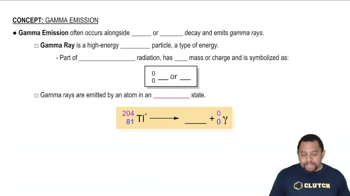A minimum energy of 7.21⨉10-19 J is required to produce the photoelectric effect in chromium metal. (b) Light with a wavelength of 2.50⨉10-7 m falls on a piece of chromium in an evacuated glass tube. What is the minimum de Broglie wavelength of the emitted electrons? (Note that the energy of the incident light must be conserved; that is, the photon's energy must equal the sum of the energy needed to eject the electron plus the kinetic energy of the electron.)
Ch.5 - Periodicity & Electronic Structure of Atoms
Chapter 5, Problem 138c
An energetically excited hydrogen atom has its electron in a 5f subshell. The electron drops down to the 3d subshell, releasing a photon in the process. (c) The hydrogen atom now has a single electron in the 3d subshell. What is the energy in kJ/mol required to remove this electron?
 Verified step by step guidance
Verified step by step guidance1
Identify the principal quantum number (n) for the 3d subshell, which is n=3.
Use the formula for the energy of an electron in a hydrogen atom, E = -2.18 \times 10^{-18} J \times \left(\frac{1}{n^2}\right), substituting n=3 to find the energy of the electron in the 3d subshell.
Convert the energy from joules to kilojoules by dividing by 1000.
Since the question asks for the energy per mole, convert the energy from kJ to kJ/mol by multiplying by Avogadro's number, 6.022 \times 10^{23} mol^{-1}.
The result from the previous step gives the ionization energy required to remove the electron from the 3d subshell of a hydrogen atom in kJ/mol.

Verified video answer for a similar problem:
This video solution was recommended by our tutors as helpful for the problem above.
Video duration:
7mWas this helpful?
Key Concepts
Here are the essential concepts you must grasp in order to answer the question correctly.
Electron Configuration
Electron configuration describes the distribution of electrons in an atom's orbitals. For hydrogen, which has only one electron, the configuration is typically 1s¹. When the electron transitions between energy levels, such as from 5f to 3d, it changes its energy state, which is crucial for understanding the energy required to remove the electron.
Recommended video:
Guided course

Electron Configuration Example
Ionization Energy
Ionization energy is the energy required to remove an electron from an atom in its gaseous state. For hydrogen, this energy varies depending on the electron's energy level. When the electron is in the 3d subshell, the ionization energy will be different from that of the ground state, reflecting the stability and energy of the electron's current state.
Recommended video:
Guided course

Ionization Energy
Photon Emission
Photon emission occurs when an electron transitions from a higher energy level to a lower one, releasing energy in the form of a photon. This process is fundamental in understanding how energy levels in atoms work, as the energy of the emitted photon corresponds to the difference in energy between the two levels. This concept is essential for calculating the energy required to remove the electron after it has transitioned.
Recommended video:
Guided course

Gamma Emission
Related Practice
Textbook Question
Textbook Question
(c) What is the velocity of an electron with a de Broglie wavelength equal to (b)?
Textbook Question
An energetically excited hydrogen atom has its electron in a 5f subshell. The electron drops down to the 3d subshell, releasing a photon in the process. (b) What wavelength of light is emitted by the process?
Textbook Question
Consider the noble gas xenon. (a) Write the electron configuration of xenon using the abbreviation of the previous noble gas.
Textbook Question
Consider the noble gas xenon. (c) The energy required to completely remove the outermost electron from the excited xenon atom is 369 kJ/mol, almost identical to that of cesium (376 kJ/mol). Explain.
Textbook Question
Red light with a wavelength of 660 nm from a 3.0 mW diode laser shines on a solar cell. (b) How much current (in amperes) flows in the circuit of the solar cell if all the photons are absorbed by the cell and each photon produces one electron?
2
views
